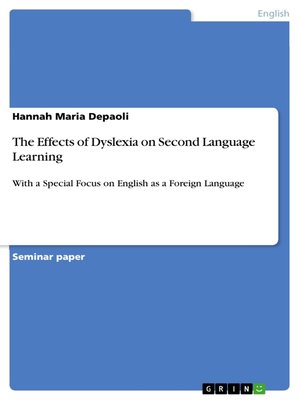The Effects of Dyslexia on Second Language Learning
ebook ∣ With a Special Focus on English as a Foreign Language
By Hannah Maria Depaoli

Sign up to save your library
With an OverDrive account, you can save your favorite libraries for at-a-glance information about availability. Find out more about OverDrive accounts.
Find this title in Libby, the library reading app by OverDrive.



Search for a digital library with this title
Title found at these libraries:
| Loading... |
Seminar paper from the year 2015 in the subject English Language and Literature Studies - Linguistics, grade: 1,0, University of Graz (Anglistik), course: Research Perspectives on Second Language Acquisition, language: English, abstract: After a general overview on Dyslexia, defining it as an impairment of the ability to recognize and comprehend written language, accompanied by difficulties in writing and spelling as well as slow reading and reduced reading comprehension, general facts about the deficit are presented, such as its prevalence and its official definition in the international ICD-10 catalogue. With regard to the effects of Dyslexia on foreign language learning the topic of orthographies is discussed and various examples for transparent and less transparent orthographies are provided, as several studies have suggested that the transparency of an orthography determines the ease and speed of reading and writing in a language. The orthography of the German and English language are discussed and differences in transparency are pointed out. German, having a rather transparent orthography, i.e. clear-cut grapheme-phoneme correspondences, is easier to adapt to than English, which has a deep orthography with irregular grapheme-phoneme correspondences. The fact that English is an obligatory subject in most curricula makes it essential to find ways to deal with its inconsistency and to design helpful material for both, normally developing and dyslexic students. Several findings about the effects of Dyslexia on foreign language learning are relevant for the foreingn language classroom. Implications for teaching techniques, material and lesson planning are discussed in this paper.






